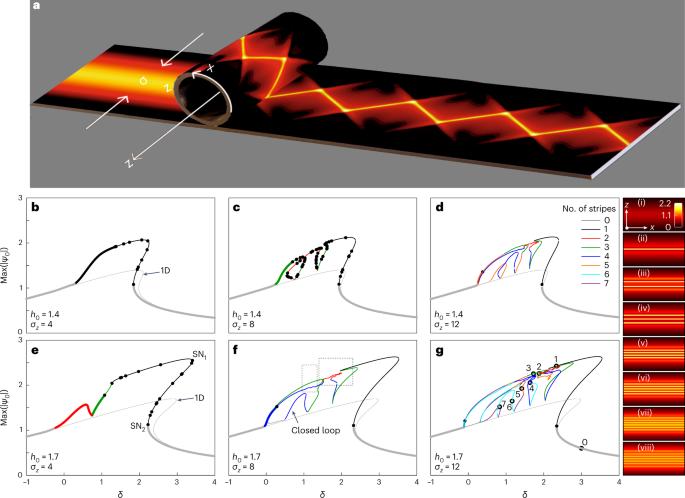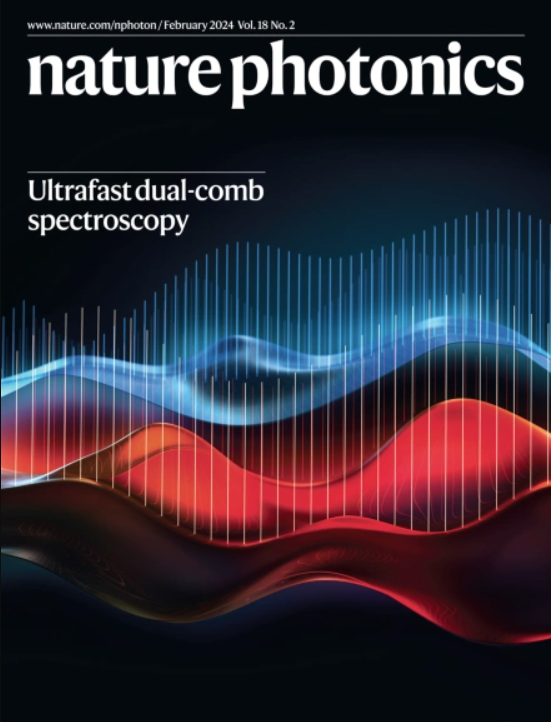二维频率梳中的光子蛇态
IF 32.3
1区 物理与天体物理
Q1 OPTICS
引用次数: 1
摘要
控制许多非线性光学现象固有的不稳定性对现代光子学至关重要。尤其是众所周知的所谓蛇形不稳定性,它会严重扭曲局部波纹,导致出现瞬时、短暂的动态状态,并最终衰减。这种现象在非线性科学中无处不在--从蜿蜒的河流到超流体--但到目前为止,它显然仍然是不可控制的;然而,我们在这里展示了光学蛇形不稳定性可以通过一种过程加以利用,从而形成静态和稳健的二维之字形状态。我们发现,这种新型非线性波存在于圆柱形微谐振器的双曲机制中,并自然对应于具有频谱异质性和内在同步性的二维频率梳。我们揭示了这种时空光子蛇存在的条件,并证实了它们对扰动的显著鲁棒性。我们的发现代表了频率梳生成的新范例,从而为通信、计量和光谱学领域的一系列应用打开了大门。通过调整二维圆柱形微腔中泵浦光束的空间宽度、强度和频率,支持稳定、稳健的光子蛇状态,可以实现一组宽带和完全同步的二维频率梳。本文章由计算机程序翻译,如有差异,请以英文原文为准。

Photonic snake states in two-dimensional frequency combs
Taming the instabilities inherent to many nonlinear optical phenomena is of paramount importance for modern photonics. In particular, the so-called snake instability is universally known to severely distort localized wave stripes, leading to the occurrence of transient, short-lived dynamical states that eventually decay. This phenomenon is ubiquitous in nonlinear science—from river meandering to superfluids—and so far it apparently remains uncontrollable; however, here we show that optical snake instabilities can be harnessed by a process that leads to the formation of stationary and robust two-dimensional zigzag states. We find that such a new type of nonlinear waves exists in the hyperbolic regime of cylindrical microresonators, and that it naturally corresponds to two-dimensional frequency combs featuring spectral heterogeneity and intrinsic synchronization. We uncover the conditions of the existence of such spatiotemporal photonic snakes and confirm their remarkable robustness against perturbations. Our findings represent a new paradigm for frequency comb generation, thus opening the door to a whole range of applications in communications, metrology and spectroscopy. By tuning the spatial width, the strength and the frequency of a pump beam in two-dimensional cylindrical microcavities supporting stable, robust photonic snake states, a set of broadband and perfectly synchronized two-dimensional frequency combs can be realized.
求助全文
通过发布文献求助,成功后即可免费获取论文全文。
去求助
来源期刊

Nature Photonics
物理-光学
CiteScore
54.20
自引率
1.70%
发文量
158
审稿时长
12 months
期刊介绍:
Nature Photonics is a monthly journal dedicated to the scientific study and application of light, known as Photonics. It publishes top-quality, peer-reviewed research across all areas of light generation, manipulation, and detection.
The journal encompasses research into the fundamental properties of light and its interactions with matter, as well as the latest developments in optoelectronic devices and emerging photonics applications. Topics covered include lasers, LEDs, imaging, detectors, optoelectronic devices, quantum optics, biophotonics, optical data storage, spectroscopy, fiber optics, solar energy, displays, terahertz technology, nonlinear optics, plasmonics, nanophotonics, and X-rays.
In addition to research papers and review articles summarizing scientific findings in optoelectronics, Nature Photonics also features News and Views pieces and research highlights. It uniquely includes articles on the business aspects of the industry, such as technology commercialization and market analysis, offering a comprehensive perspective on the field.
 求助内容:
求助内容: 应助结果提醒方式:
应助结果提醒方式:


